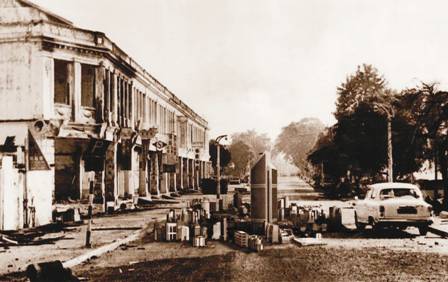 |
|
|---|---|
| CP Foundation | About CP Biennale | 2003 | 2005 | Contact Us | |
         
|
|
|
Taking It Personally Nadiah Bamadhaj (born 1968 in Petaling Jaya, West Malaysia) had been trained in both sculpture and sociology at the University of Canterbury in New Zealand, where she obtained her BFA in 1992. She has worked in non-government organizations on HIV/AIDS prevention and on human rights advocacy. In 2002 she was awarded the Nippon Foundation's Asian Public Intellectual Fellowship, in which she then elected to spend her yearlong fellowship period in Yogyakarta, Indonesia, where she currently lives. In 2004, Ms Bamadhaj held her solo exhibition titled "enamlima sekarang" at the Lontar Gallery, Jakarta. Her other solo exhibitions include "1965 Rebuilding Its Monuments" at the Petronas Gallery, Kuala Lumpur, Malaysia (2001), and "Hanging with the Boys", site-specific installation as a part of Pinkfest 1995, World AIDS Day, Kapitan's Club, Kuala Lumpur, Malaysia (1995). Taking It Personally attempts to look at certain architectural sites in Kuala Lumpur in the context of memory. Each architectural form marks a period in Kuala Lumpur's architectural and political history: The Royal Selangor Club and green turf, built by the British in the 19th century, which was a “British only” space until the 1940s; the concrete-clad Angkasapuri building, the first broadcast center of the newly independent 1960s; the Maybank building, one of the first 1980's towering high-rises of the Mahathir-era; and the Palace of Justice built in the new “intelligent” city of Putrajaya at the turn of the millennium. Like history, architecture is a state enterprise, built and produced at certain periods to exemplify the visions of its producers. Like history, too, architecture is further marked by the personal memory of its viewer. My selection of buildings is based on my personal memory of those sites and their corresponding political periods. In my readings of these architectural sites I see ironies and incongruities of these forms in relation to my readings of history. I therefore compress time between these forms and their past by placing them in selected old photographs. My selection of the photographs is based less on the intent of the photographer and the historical event, but more on my own personal memory and interpretation of the image. In the compression of architectural form and historical event a new interpretation can be made of both elements. (Artist's Statement) |
|
|
CP foundation | About CP Biennale | 2005 Biennale | 2003 Biennale | Contact Us
Jl. Suryopranoto 67A, Jakarta 10160, Indonesia. ph. +62.21.3448126, 3853206 | fax. +62.21.3853203, 3853208 info@cp-foundation.org |
